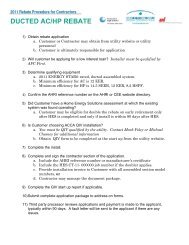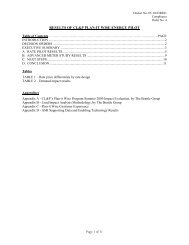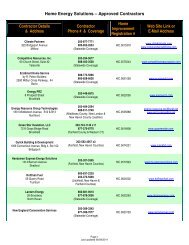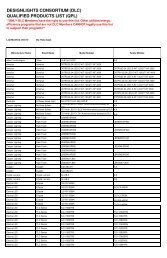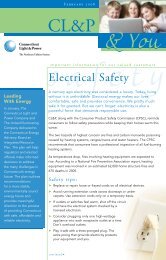Opinion - Northeast Utilities
Opinion - Northeast Utilities
Opinion - Northeast Utilities
Create successful ePaper yourself
Turn your PDF publications into a flip-book with our unique Google optimized e-Paper software.
Docket No. 424 - Interstate<br />
<strong>Opinion</strong><br />
Page 6<br />
The Council finds that the Hawthorne Lane Alternative is a well thought out plan with minimal adverse impact.<br />
The Council will leave the final decision on this portion of Interstate to the D&M Plan.<br />
IV. System Alternatives<br />
The route chosen by the Council has emerged from a series of alternative solutions explored and rejected for<br />
NEEWS during earlier phases of ISO-NE and utility planning studies, as well as a progressively detailed set of<br />
options investigated by CL&P for the Connecticut portions of NEEWS. At various points along the way, not only<br />
transmission system alternatives have been considered, but also non-transmission alternatives, or NTAs. For<br />
Interstate, the NTA of No Action was eliminated first, on account of pressing problems with reliability in Rhode<br />
Island. A CL&P consultant, ICF International, Inc. (ICF) modeled various other NTAs that might plausibly be<br />
available within southern New England during the planning period of 5 to 10 years. The scenarios included<br />
generation only, demand resources only, and a combination of generation and demand-side resources. Powerflow<br />
simulations were used to determine whether a given NTA would match the proposed Interstate’s<br />
performance in eliminating thermal violations. ICF’s final report concluded that none of the NTA scenarios<br />
performed as well as Interstate. The Council thus finds that NTAs are not an adequate solution for meeting the<br />
regional reliability need, and agrees with CL&P’s decision to pursue further only transmission alternatives.<br />
The need for Interstate discussed earlier in this <strong>Opinion</strong> establishes certain key facilities that any alternative route<br />
through Connecticut must connect, namely, the Card Street Substation, Lake Road Switching Station, and<br />
National Grid facilities at the Rhode Island border. CL&P eliminated certain all-new alternatives in this area of<br />
northeastern Connecticut, such as transmission lines running all overhead or all underground on new ROWs. The<br />
linear railroad, pipeline, and highway corridors that might hypothetically allow such use are not evident in this<br />
area. Besides, these corridors are typically are too narrow to be developed for transmission lines. Such problems<br />
could possibly be surmounted by buying raw land, but, given that existing transmission-line ROWs are available,<br />
the Council sees no justification for the expense or environmental impact of developing raw land for all-new<br />
alternatives, and concurs with CL&P’s decision to exclude them.<br />
After taking first and second cuts at a route by carving off the NTAs and the all-new transmission alternatives,<br />
CL&P presented its base design route to the Council. This included one large-scale alternative, the Combination<br />
Alternative, which would go underground along a combination of highway and transmission-line ROWs, with a<br />
short portion of overhead; or a variation of that alternative called the Route 44 Underground Variation. Further<br />
included were about ten other variations designed to solve certain potential or actual constraints and design<br />
problems for short segments of the route. The Council evaluated the large-scale Combination Alternative, its<br />
variation, and all the other variations in order to determine the final route.<br />
The Council began by categorizing the alternate and variations in terms of whether they were designed to go<br />
overhead or underground. Overhead lines and structures generally do less environmental damage than cables<br />
underground. Cables, being “invisible” to the public, appear to pose no environmental issues at all, an appearance<br />
that is misleading. Overhead systems leave relatively small footprints overall, can span environmentally sensitive<br />
areas, call for less clear-cutting, decrease the need for access roads, involve lower line-losses and fewer other<br />
inherent electrical problems. Cables can only be developed on a continuous corridor with an access road along its<br />
full length; they cannot easily accommodate significant grade changes in terrain; they demand numerous splice<br />
vaults that are bulkier than the cable ducts, as well as transition stations at either end where the cables connect to<br />
the overhead system; and cables’ operating characteristics are considerably more complicated than those for<br />
overhead lines. These drawbacks for underground systems, and other problems, have costs. While estimates do<br />
differ, typical costs per mile for underground systems are at least five times the costs per mile for overhead. In<br />
this regard, the Council noted, based on past experience with ISO-NE cost allocations rules and procedures, that<br />
100% of the incremental cost for underground systems would likely be charged to Connecticut ratepayers.



